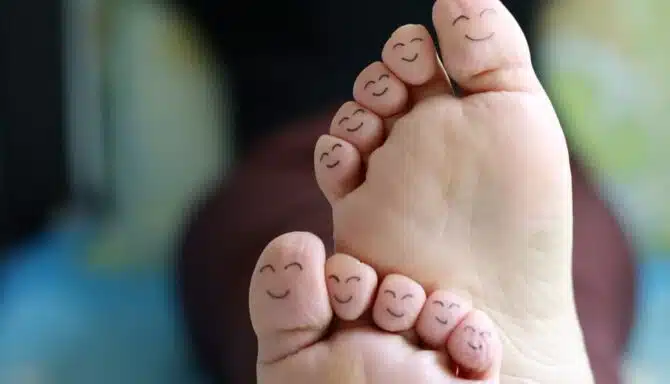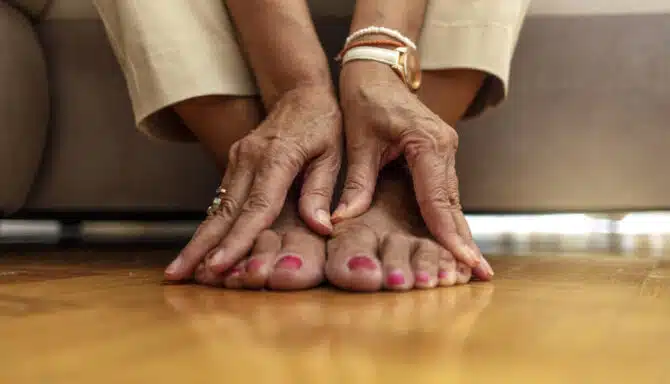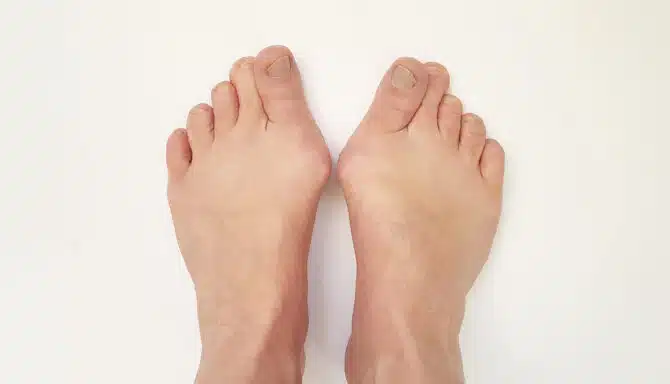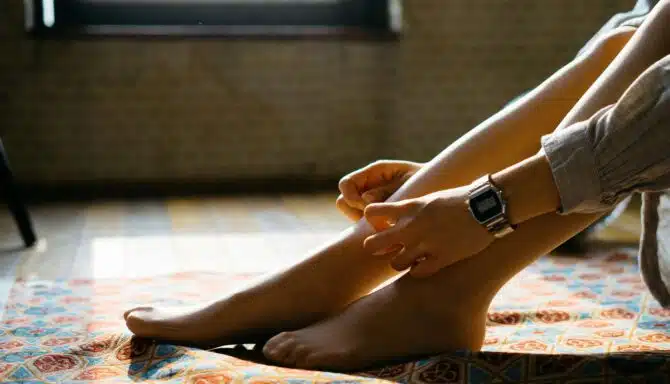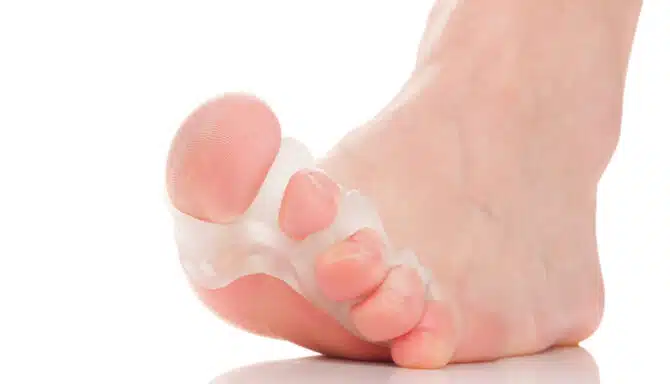February 13, 2025
From athletes to homebodies, toe spacers are all-the-rage these days and provide many benefits. Toe spacer benefits include correcting toe misalignment, better balance and posture, foot pain management and even improved circulation, making them a great foot care tool. They can also help with conditions like bunions and hammertoes. But exactly how toe spacers help your feet comes down to their ability to gently separate the toes into their natural position. Let’s take a look at everything there is to know about how you can use toe spacers to improve your foot health, the different types of toe spacers, and more!
What Are Toe Spacers?
Toe spacers are small devices placed between the toes to create separation and encourage proper toe alignment.
They come in various designs, colours and may be made with different materials, but their primary function is to counteract the tendency of toes to crowd together. This separation helps maintain the foot's natural shape by preventing the toes from overlapping or pressing against each other. While commonly associated with bunion and hammertoe relief or foot pain management, toe spacing devices also play a role in reshaping the way the toes interact with the ground. This improves overall foot mechanics—which in turn can help prevent even more foot conditions. But you don't need to have a foot condition to benefit from toe spacers: many professional athletes use them too!
The way toe spacers work is rooted in biomechanics and how the foot is structured to distribute weight and movement. The toes are meant to splay naturally when standing, walking, or running, which helps with balance and stability. However, when toes are compressed for long periods, the ligaments, tendons, and soft tissues adapt to this restricted position. Toe spacing devices apply gentle but consistent pressure to push the toes apart, stretching these tissues, opening the joint spaces and encouraging them to return to a more natural alignment. This process doesn’t happen instantly but occurs gradually as the foot readjusts, influencing how force is distributed with each step.
If you’re wondering if toe spacers will work for you, you can consult with a foot specialist like a Podiatrist or a Chiropodist. They are also available to purchase at our Toronto foot clinic, in addition to many other useful foot care tools!
https://youtube.com/shorts/fFNkHZ-xqZM?feature=shared
Types of Toe Spacers
Many varieties of toe spacers are made with silicone gel as it’s a durable material and easy to clean. Some toe spacing devices are slim enough to fit comfortably inside shoes, making them ideal for all-day wear, while others are thicker and designed for use while resting. They also come in both four-toe and five-toe variations—the only difference being whether the pinky toe is separated.
According to Runner’s World, four-toe spacers are great for mobility exercises and yoga, while five-toe spacers provide better support during workouts and daily activities.
Since foot conditions like bunions primarily affect the big toe, some spacers are designed specifically for that toe. While technically more of an “aligner” than a “spacer,” the Infracare Ultra Thin Bunion Aligner is a good toe spacer for bunions made from a gentle material called power net and easily slips over the big toe.
https://youtube.com/shorts/8g43ZWreZ1g?feature=shared
Benefits of Toe Alignment and Toe Spacers
Toe spacers help a wide range of individuals—from athletes to those with severe toe deformities and mobility issues. They offer the following benefits:
1. Improved Toe Alignment
Toe spacers help open the joint spaces and restore more of the natural spacing between toes, which is often lost due to years of wearing narrow and restrictive footwear. By gradually repositioning the toes, they encourage a more anatomically correct foot shape and improve overall foot function.
2. Better Foot Stability and Balance
Proper toe alignment allows for a wider and more stable base of support, improving balance and weight distribution. This is particularly beneficial for activities that require strong foot control, such as running, yoga, and weightlifting.
3. Reduced Muscle and Joint Strain
Misaligned toes affect how the foot moves. This means muscles have to compensate and move in ways they weren't designed to, leading to strain on surrounding muscles, tendons, and joints. Toe spacing devices help the foot function more naturally, reducing stress on the plantar fascia, ankles, knees, and even the lower back. Remember, everything is connected!
4. Increased Toe Mobility and Strength
Separating the toes promotes greater movement and activation of the small intrinsic foot muscles inside the foot (there are also many exercises that work these muscles!). Over time, this can improve toe dexterity, making movements like toe spreading and gripping more effective. This is helpful for both everyday activities and athletic performance.
5. Enhanced Circulation
Tightly compressed toes can restrict blood flow to the feet. Toe spacers encourage better circulation by relieving pressure between the toes, potentially reducing numbness, tingling, and cold feet.
6. Reduce Friction
Toe spacers may help reduce the uncomfortable friction in your shoes that leads to skin conditions like calluses, corns and blisters.
Benefits of Toe Spacers for Athletes
Athletes, especially runners, lifters, and those who practice barefoot activities like yoga, or even martial arts, rely on strong, well-aligned feet for optimal performance. Toe spacers encourage natural toe splay, which improves ground contact and enhances stability during movement.
For runners, this means better natural shock absorption and energy transfer with each step, reducing the ground’s harsh impact on the knees, ankles and rest of the foot. Weightlifters benefit from a stronger, more stable base when performing compound lifts like squats and deadlifts, as the toes are better positioned to distribute force evenly through the foot. NFL star George Kittle was even shown using them in the Netflix series Receiver.
Additionally, because toe spacers promote intrinsic foot muscle activation, they help athletes build strength in the smaller stabilizing muscles of the feet, which can reduce the risk of overuse injuries like plantar fasciitis and metatarsalgia, as well as stress fractures (tiny cracks in the bones of the foot).
They can also prevent cramping and foot fatigue, particularly during long training sessions. By keeping the toes properly aligned, spacers relieve tension and improve circulation, helping to prevent that burning or aching sensation after prolonged activity. They also encourage proper foot posture and a normal gait, which can positively affect overall biomechanics.
Benefits of Toe Spacers for Bunions and Hammertoes
Bunions and hammertoes are common foot deformities that develop from prolonged toe misalignment, often made worse by wearing tight or ill-fitting footwear for years. For toe deformities, toe spacing devices help to push the big toe away from the second toe in the case of bunions and allow curled toes to stretch into a more natural position for those with hammertoes. This not only slows the progression of these conditions but can also help alleviate pain caused by pressure and friction between the toes.
For individuals with bunions, toe spacers help counteract the drift of the big toe by encouraging it to stay aligned with its natural position. Over time, this can reduce strain on the first metatarsophalangeal (MTP) joint, which is where bunions form. By keeping the toe straight, spacers can also relieve pressure on the bunion itself, making it easier to wear shoes without pain. While toe spacers won’t reverse a bunion, they can help manage symptoms and prevent further misalignment.
Hammertoes, on the other hand, often develop due to an imbalance in muscle and tendon function, causing one or more toes to remain in a bent position. Toe spacers gently stretch and realigning these toes, reducing stiffness and preventing them from becoming more rigid over time. This can improve comfort when walking and reduce the likelihood of corns or calluses forming due to excessive friction.
Toe spacers offer a simple yet effective way to improve foot health, whether you're looking for better performance in sports or relief from common foot conditions. As always, it’s best to consult with a Podiatrist or Chiropodist before trying them yourself, especially if you aren’t sure what material or type to use.
https://www.youtube.com/shorts/MZQ835Mw0I0
How to Wear Toe Spacers With Your Shoes
To wear toe spacers with shoes, start by selecting a low-profile design that fits comfortably inside footwear. First, put on your spacers while barefoot and ensure they sit snugly between your toes without discomfort.
Next, choose shoes with a wide toe box to accommodate the extra space needed for proper toe splay—narrow or tight-fitting shoes may compress the spacers and reduce their effectiveness. Plus, you shouldn’t wear ill-fitting shoes anyway!
When putting on your shoes, loosen the laces or straps to allow more room, and consider wearing thinner socks to prevent excess bulk. Walk around to check the fit, making sure your toes can move naturally without pressure points. Begin with short wear times, such as 30 minutes to an hour, and gradually increase as your feet adjust.
Remember: only thinner toe spacers will fit into your shoes. Thicker toe spacers like Yoga Toes are designed to be worn barefoot.
https://www.youtube.com/shorts/sXF8lWHad0g
November 21, 2024
Bunions can target anyone, but they are more common in older women due to factors like foot anatomy and footwear choices. Luckily, there are ways you can prevent and manage bunions to the best of your ability, especially if you work with a chiropodist or podiatrist. Let’s explore everything there is to know about bunions, including the reasons why older women are more at risk for developing bunions.
https://youtube.com/shorts/sXF8lWHad0g?si=w38l2AbSdGSpctbC
This article will answer:
What are bunions?
Who's at risk?
Why are older women at risk?
How do you treat bunions?
How do you prevent bunions?
Do I need bunion surgery?
What Are Bunions?
Bunions are toe deformities in which the big toe shifts towards the second toe at an angle. This causes the joint at the base of the big toe (the first metatarsophalangeal joint, or MTP joint) to protrude outwards, forming a bump that can become swollen, tender, and uncomfortable. The MTP joint bears a lot of pressure while walking or standing, which can worsen the bunion over time. As the condition progresses, people with bunions often experience pain and difficulty wearing certain shoes.
Another related condition common in older women is hallux rigidus, where arthritis or stiffness affects the big toe joint, limiting its movement. Hallux rigidus may not cause the same protrusion as bunions (it's usually seen on top of the joint), but it can still lead to pain and difficulty moving the toe. Many people may think that hallux rigidus is the same as a bunion, but they are different - the scientific term for bunions is hallux (abducto) valgus.
Causes of Bunions: Who's at Risk?
While bunions aren't typically caused by one thing alone, there are several risk factors that contribute to the likelihood of developing bunions. All these risk factors either weaken or cause extra strain on the MTP joint. These include:
Age: Bunions can start to form as young as 30, but they are commonly associated with seniors and become more debilitating and noticeable with age. Some studies suggest 1 in 3 people over the age of 65 have a pronounced bunion, many of them being women.
Genetics: Bunions are partly genetic because foot shape and structure, often inherited traits, can increase the risk of developing them. People with certain foot shapes—particularly flat feet—are more prone to bunions because this structure creates imbalanced pressure on the big toe joint.
Wearing ill-fitting footwear: Frequently wearing narrow, tight, or high-heeled shoes that squeeze the toes can push the big toe inward, contributing to bunion formation. Pointed, unstready high-heeled shoes with very thin heels (like stilettos) are extra risky.
Having Rheumatoid arthritis: Conditions that affect joint health and increase inflammation, such as rheumatoid arthritis, can lead to bunion formation.
Previous foot injuries: Tendon tears, or having broken a bone in the past, can increase risk.
Why are Older Women at Risk?
Senior women are more likely than other groups to experience painful bunions for a handful of reasons:
Older people are more susceptible to joint-wear-and-tear and other foot conditions like osteoarthritis (which is caused by wear-and-tear on the joints, and is commonly associated with age). And pre-existing joint issues make you more prone to bunions.
Many older women have a history of wearing ill-fitting shoes with cramped toe boxes and unsteady high heels for decades. Tight shoes and high heels put extra strain and pressure on the MTP joint. The collective effects of this pressure accumulate over time and, compounded with other age-related risk factors, can accelerate, contribute to or exacerbate the formation of bunions.
Women may have weaker connective tissue in their feet. This will reduce the big toe's ability to withstand the force and pressure of our movement.
Bunions can worsen during menopause due to hormonal changes loosening ligaments and flattening the feet, making them more vulnerable. This can also happen during pregnancy and have long-lasting effects on the feet. Menopause can also affect bone density, which can accelerate joint degeneration, weaken joints, and therefore aggravate bunions.
Bunions in Older Women: Treatment
If you are struggling with bunion pain, visiting a foot specialist, like a chiropodist or podiatrist, at your local foot clinic can help. There are many solutions available that target the foot pain and mobility issues associated with bunions, while decreasing pressure on the big toe joint. While bunions cannot be reversed (without surgery), by strengthening your feet and reducing pressure on the big toe, you can manage the bunion growth so that it doesn't get worse.
Bunion Exercises and Stretches
https://www.youtube.com/shorts/H3SogJ8FIas
A chiropodist or podiatrist may suggest some bunion exercises and stretches. These are great for both prevention and treatment, mostly target the toes, are easy to memorize, and accommodate seniors. The exercises may feel awkward at first, but you’ll get used to them in no time.
Here are five easy-to-learn exercises you can incorporate into your daily routine to help manage bunion discomfort:
Toe Circles
Grip your big toe and move it in circular motions to maintain joint mobility. Do 10 circles in each direction per foot.
Toe Stretches
Use your fingers to press your big toe down and hold for 30 seconds, then stretch it in the opposite direction for another 30 seconds. Repeat 5 times on each foot.
Towel Grip and Pull
Place a towel on the floor and use your toes to scrunch and pull it toward you. This helps strengthen the small muscles in your feet.
Toe Curls and Spreads
Curl your toes down tightly, hold for a few seconds, then spread them wide. Repeat this motion 10 times per foot to improve flexibility and strength.
Toe Resistance Exercises
View this post on Instagram A post shared by Feet First Clinic (@feetfirstclinic_)
Use your fingers to apply light pressure against your big toe in various directions, pressing up, down, and sideways. Hold each for 10 seconds. Repeat 5 times on each foot.
You can also wrap a resistance band around your big toes and then spread your feet apart while keeping your heels planted, as shown in the video above.
Other bunion treatment options provided by a foot specialist include:
Footwear recommendations: We'll get more into this later, but opt for shoes with a wide toe box that give your toes enough room. You should also look for features like cushioned insoles and good arch support to reduce pressure on the bunion.
Custom orthotics: A foot specialist will assess your feet and design custom orthotic insoles tailored to your feet. Orthotics work by reducing pressure and force on the big toe joint, which will then reduce bunion pain and help prevent the bunion from getting worse. Custom orthotics for bunions provide support and help realign the foot, redistributing pressure away from the bunion. You can then put the orthotics into your footwear and go about your daily activities with less pressure on the big toe.
Shockwave therapy: This treatment uses powerful acoustic pulses to reduce pain in the affected area by increasing blood flow and triggering a process that helps the body heal injured tissue. While shockwave therapy doesn't target the bunion itself, it helps with the tight muscles and ligaments around the bunion, which reduces pain and pressure on the joint.
Bunion devices: These devices help realign the toes to varying degrees. Silicone toe separators are great for when you're walking around at home, whereas ultra-thin bunion aligners fit comfortably in most footwear and are great for athletic people. For more significant correction, rigid bunion splints help stabilize the joint.
Therapeutic taping: A foot specialist can apply therapeutic tape to provide support, reduce pain, and help correct the alignment of the bunion, allowing for better mobility.
Shoe stretching: If your shoes are too tight, professional shoe stretching can help relieve pressure on the bunion, making footwear more comfortable.
https://www.youtube.com/shorts/8g43ZWreZ1g
Best Bunion Prevention Tips
There isn’t much you can do about your genetics or age, but you can be mindful about other lifestyle factors to manage bunion formation.
Wearing the Right Footwear
The best preventative measure you can take to try and avoid bunions is wearing the right shoes for your feet.
You should be especially vigilant about finding shoes that are wide enough for your toes to rest comfortably and wiggle without crowding and overlapping. Ideally, your shoes need between ⅜” to ½” of space between the end of your longest toe and the front of the shoe. You can try an at-home test to see how wide your feet really are before visiting your Toronto foot clinic for a shoe fitting that will help you find the perfect fit.
Toe space is the biggest factor for bunion prevention, but there are many other things to consider when finding the right shoes. Check out the best footwear for healthy feet to learn what else you should look out for.
Try to avoid high heels, only wearing them for special occasions. Even then, opt for healthy heel options. Heels shouldn’t be too high or too thin—look for a block, shorter heel or wedges instead. Your shoes also shouldn’t be severely pointed and squish your toes together.
Additional Bunion Prevention Tips:
Regular exercise and a good fitness regimen will help keep your muscles strong. Strong muscles reduce strain on the joints, which will then make you less susceptible to joint degeneration and wear-and-tear as you age. In addition, a healthy conditioned lower body and core helps with alignment and weight-bearing, meaning your big toe won't need to work as hard when you move around.
Since having a previous injury can be a risk factor, practice healthy foot injury prevention and FALL prevention.
If you notice early signs of bunion formation, such as redness or swelling around the big toe joint, consult a foot specialist promptly.
You should also consult a foot specialist if you have any family members with bunions, notice any issues with your alignment, have flat feet, or any other biomechanical concerns, as faulty biomechanics increase strain on the big toe joint.
Excess weight can put additional pressure on your feet, increasing the risk of bunion development. Maintaining a healthy weight can help reduce this strain.
Do I Need Bunion Surgery?
Seniors may be more likely to seek a surgical consult after living with bunions for a longer period than young people, and trying other non-invasive treatment options with a podiatrist or chiropodist first.
That said, these days there are more non-surgical treatment options than ever before and your chances of needing a surgery are still somewhat low. Surgeries are typically recommended for older women or any individual who experiences significant pain or functional limitations; surgeries are not usually performed solely for cosmetic reasons.
At FeetFirstClinic you will start with a full foot assessment to determine the severity of your condition and your foot specialist will form a treatment plan with you.
https://www.youtube.com/shorts/XZUfVhny5pY
August 12, 2024
Dealing with bunions can be a pain—literally. For those managing bunions, finding effective solutions can greatly improve quality of life. Let's dive into various bunion treatment options and explore lifestyle tips that can help alleviate discomfort and prevent further issues.
Bunion Treatment Options: Finding What Works for You
When it comes to managing bunions, there's no one-size-fits-all approach. Remember, they are bony protrusions and can vary in pain level and size. While they can occur in both men and women, they are most common in women. Non-surgical bunion treatment is often the first line of defense.
Non-Surgical Bunion Treatment
Ill-fitting and unsupportive footwear - particularly narrow shoes and high heels - is one of the most common causes of bunions. A chiropodist can suggest footwear for bunions that provide ample toe space and cushioning. They'll help you discover fashionable footwear for sensitive feet from your local Toronto foot clinic. Additionally, they can do a biomechanical assessment to determine if custom orthotics can help manage the bunion's progression and reduce your pain.
A chiropodist can also recommend bunion cushioning techniques and products, such as:
Silicone toe separators
Bunion aligners
Rigid, yet walkable, bunion splints
These non-invasive measures can help reduce pressure on the affected area and offer bunion pain relief.
Lifestyle Tips For Bunion Relief and Preventing Bunion Progression
As with any foot condition, lifestyle changes go a long way!
Implement simple bunion exercises into your routine to strengthen the muscles around the joint. To give it your best shot, refer to these 5 simple exercises for bunions!
It is also strongly recommended that you avoid high heels. If you have a special event, visit your local foot clinic to talk about comfortable heel and wedges you may be able to wear, for a limited amount of time.
In addition, avoid activities that put excessive pressure on your feet, such as long periods of standing on hard surfaces. You can try beginner-level, low-impact yoga to keep moving, but make sure it isn't too intense for your feet.
Surgical Solutions
In severe situations, bunion surgery from a podiatrist or orthopaedic surgeon can offer significant relief. Surgery realigns the toe joint, providing a long-term solution and eliminating the need to accommodate the bunion at all times.
However, it's crucial to consult with a healthcare professional to determine if surgery is the right step for you. Most of the time, surgery is only an option for severe bunions as it can be a lengthy and inconvenient process for you. In addition, there's no guarantee the bunion will not return: some studies indicate a reoccurence rate of up to 25% after bunion surgery.
It's important to note that bunion surgery alone isn't going to permanently get rid of your bunions: you still need to do non-surgical bunion treatment options after surgery to prevent reoccurence, namely:
Wear proper fitting footwear and avoid high heels
Strengthen and condition the muscles in your feet and ankles
Address any underlying biomechanical issues to reduce pressure and strain on the affected joint.
August 8, 2024
When we think about flexibility, our toes might not be the first body part that comes to mind. One may think that because they're so small, you can get away with neglecting them. However, our toes are actually part of our entire body's foundation. Flexible toes protect us from many short—and long-term foot conditions and can enhance our quality of life.
Let's explore the benefits of having flexible toes, including improved balance, fewer foot problems, and increased toe functionality.
Five benefits of flexible toes
1. Improved balance and stability
Flexible toes contribute to better balance and stability. When your toes can move and spread naturally, they can adjust to uneven surfaces and provide a broader support base, enhancing overall stability while walking, running, or standing.
2. Fewer foot problems
Maintaining flexibility in your toes can help prevent common foot problems associated with stiffness in your toes. For example, a limited range of motion in your feet can indicate bunions, hammertoes, osteoarthritis, hallux rigidus, and plantar fasciitis early. Hallux rigidus and hallux limitus translate to "rigid" and "limited," a direct sign of stiff toes.
In addition, flexible toes are less likely to become cramped or develop abnormal positions that can lead to discomfort and pain. Greater flexibility also means your muscle groups will work in balance, whereas stiff toes can overstress particular parts of your feet when they compensate for the stiffness.
You may also benefit from a reduced risk of one-time acute injuries like turf toe. With greater flexibility and range of motion, your toes can safely extend to positions they would not be able to if they weren't flexible.
3. Better proprioception
Proprioception is the body's ability to sense its position and movement in space. Flexible toes contribute to better proprioception in the feet, allowing for improved feedback to the brain about the terrain you're walking on, which aids in maintaining balance and preventing injuries.
4. Greater toe functionality
Flexible toes can better perform their natural functions, such as gripping the ground while walking or running. A greater range of motion helps propel you forward and reduces strain on other parts of the foot. Regular toe exercises can also increase blood flow to your toes, reducing swelling and inflammation.
5. Reduced risk of falls
Maintaining flexibility in your toes can reduce the risk of falls, especially among older adults. Flexible toes help adapt to sudden shifts in weight distribution and uneven surfaces, decreasing the likelihood of tripping or losing balance.
July 22, 2024
Sometimes with aging feet comes the development of toe deformities, particularly hammertoes. Studies show that approximately half of women over 70 have some version of a toe deformity (but they can happen to anyone). Many assume correcting hammertoes always leads to a daunting surgery, but guess what? Surgery is not usually the first option and is generally only considered when the toe becomes rigid, or other complications arise. Read today’s article to discover the best non-surgical solutions for hammertoes and toe alignment techniques that achieve amazing results.
Top Hammertoe Treatment Options
Innovation in foot care and toe straightening methods have lead to plenty of non-surgical solutions for hammertoes and the pain they cause, including:
Splinting, taping and bracing
Custom orthotics and new footwear
Shockwave therapy
At-home exercises
Other treatments
Splinting, Taping and Bracing
These non-invasive tools are great for dealing with toe curvature. All performed by a licensed Toronto chiropodist, splinting, taping and bracing helps straighten the toe, reduces friction and discomfort (corn development is common for people with hammertoes) and provides support and alignment.
Custom Orthotics And Footwear Changes
Custom orthotics are all about placing each part of your foot where it’s supposed to be, including toes. Wearing orthotics can properly align the joint in your toe and relax the burden on the affected tendons. Most importantly, they'll offset and redistribute pressure away from the toes. This will reduce strain on the hammertoes when you walk, which will help prevent them from getting worse.
As for footwear, avoid high heels if you have any toe deformity; they’re notorious for making hammertoes worse. Wear wide shoes, maybe even orthopedic shoes, that allow your toe abnormalities to exist comfortably and reduce pain as much as possible. Most importantly, make sure your shoes fit: If your shoes are too short, your toes will curl, which will make your hammertoes worse. (In fact, ill-fitting footwear is a major contributing factor to hammertoes.)
Shockwave Therapy
It’s clear that when you have hammertoes, your joints and tendons take a hit. They stiffen up, become quite painful, and may even weaken your muscles over time. Shockwave therapy is a non-invasive treatment that may help treat your tendons and ligaments.
At-Home Exercises
Check out exercises and stretches that help treat the top of the foot to soothe your hammertoes and strengthen your feet and muscles in general. Many of these target the toes and surrounding area. Strengthening the muscles in your feet ensures that the toes and joints don't get overworked or strained when you walk, which helps manage hammertoes and provides hammertoe pain relief.
Over-the-Counter Products
Gel separators, toe spacers, pads, cushions and more can help you take control of your hammertoes without resorting to surgery. Call your local Toronto foot clinic to see what they have in stock!
June 18, 2024
Foot-friendly shoes and comfortable heels as wedding guest footwear? Who knew there could be such a thing! Say goodbye to the days where you have to switch shoes halfway through the wedding reception and say hello to stylish comfort shoes, pain-free heels and podiatrist-approved footwear. Today’s article will guide you towards discovering brands that make comfortable wedges and heels for when you want to attend an exciting summer wedding, but don’t want to deal with dreaded foot pain!
Brands That Make Comfortable Wedding Season Footwear
Check out some foot clinic recommendations for wedding guests, bridal parties and bridal shoes! These brands are available at Feet First Clinic - your favourite local Toronto one-stop-shop for all things foot health!
Ara
Ara combines the perfect fit with sleek style, making the ideal shoe. They have plenty of pumps, sandals, and other shoes with a short-to-moderate heel height that will help you maintain your balance and stability at the wedding, in addition to preventing nagging foot pain. They use the same comforting shoe technologies and materials as their walking shoes.
NAOT
NAOT is another ideal choice for comfortable heels and wedges. Whether you're walking down the aisle or dancing the night away, you'll find a good combination of fashion and comfort with their sandals, booties and other shoes. If you're more into fun shoe designs and prefer a short heel with minimal elevation, they might be a good choice for you.
The NAOT Pixie might be a good choice for a wedding guest who wants a very short heel that still has some elevation.
Clarks
Clarks has always been innovative in shoemaking, introducing technologies that make you feel like you’re stepping on a cloud. This also applies to their chunky wedges, heeled sandals, boots, booties, and more — all perfect for summer weddings! Emphasizing proper fit and comfort with cushioned insoles and ergonomic designs and high-quality materials such as soft leathers, Clarks ensures that every pair minimizes foot pain as much as possible.
Give our Toronto foot clinic a call for the most up-to-date shoes from Ara, NAOT and Clarks in stock! You can also stop by our Bloor West location for a shoe fitting.
A Final Note on Heels and Wedding Season in 2024
It’s tough to find the right balance between high heels and foot health. We recommend avoiding them if you have certain foot conditions like severe bunions, hammertoes, joint pain caused by arthritis, amongst others. But then again, if you like heeled shoes, there should be a way to stay true to yourself, especially for a special occasion. Look for:
Wide-toed shoes: Opt for heeled shoes with a wide and deep toe box.
Low heels: Select heels that are no higher than 2 inches to reduce strain.
Soft materials: Look for shoes made from soft, flexible materials like leather or suede that can stretch and conform to the foot shape.
Cushioned and removable Insoles: Shoes with cushioned insoles can provide extra comfort. Removing them and inserting your own custom orthotics or insoles for your foot type is also a wise move.
Remember: if your shoes exacerbate your condition, don’t wear them, even if you’ve followed these guidelines. Walking shoes and orthopedic shoes can look lovely at a wedding too! Many brides wear them to add a fun, casual spin to their wedding look.
Check out this blog on balancing elegance with foot health for even more tips on selecting the right wedding shoes this summer.
